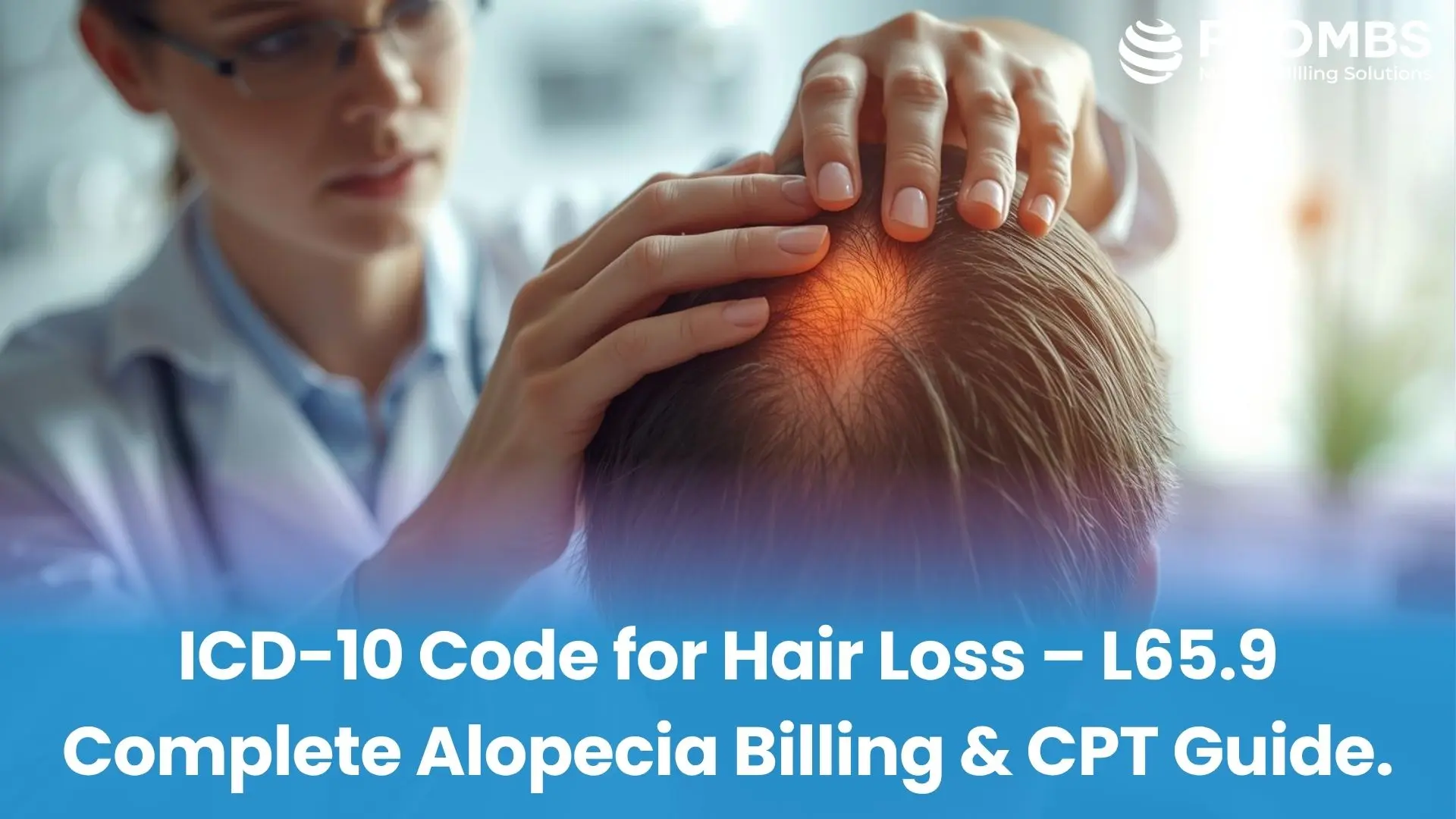Hair loss, or alopecia, affects over 80 million Americans, according to the American Academy of Dermatology. While it is often viewed as a cosmetic problem, in clinical practice it can be a sign of endocrine imbalance, autoimmune disease, nutritional deficiency, or even medication side effects.
From a medical billing and coding perspective, hair loss matters because reimbursement depends on precise documentation and correct diagnosis coding. The Centers for Medicare & Medicaid Services (CMS) warns that the overuse of vague codes like L65.9 (unspecified hair loss) is a common trigger for improper payments and payer audits. This is why assigning the correct icd 10 code for hair loss is crucial for compliance, claim approval, and denial prevention.
What Are the Symptoms of Hair Loss That Support its icd 10 code?
When assigning the icd 10 code for hair loss, it is important that symptoms are fully documented, since vague notes like “hair thinning” often lead to denied claims. Providers should describe the pattern (diffuse vs. patchy), presence of scarring, severity, and suspected etiology. This helps coders select the most specific ICD-10 code and ensures compliance with CMS coding rules.
| Clinical Symptom | Documentation Needed | ICD-10 Coding Direction |
|---|---|---|
| Diffuse Thinning | Must confirm nonscarring per NIH dermatology guidance | Assign L65.9 – Nonscarring hair loss, unspecified, when cause not defined |
| Patchy Bald Spots | Document autoimmune suspicion as recommended by the American Academy of Dermatology | Assign L63.9 – Alopecia areata, unspecified, if no subtype is listed |
| Scarring Alopecia | Confirm with biopsy results, as outlined in NIH clinical textbooks | Assign L66.x – Cicatricial alopecia, depending on subtype |
| Patterned Thinning (Male/Female) | Indicate androgenic type in line with MedlinePlus clinical summaries | Assign L64.9 – Androgenic alopecia, unspecified |
| Diffuse Shedding After Stress/Illness | Document timeline and trigger as detailed in NIH hair loss resources | Assign L65.0 – Telogen effluvium |
Accurate documentation of these symptoms makes the difference between an unspecified claim denial and a paid claim. Billers should always double-check that clinical notes match the chosen code family before submission.
Did You Know? The National Institutes of Health estimates that telogen effluvium accounts for up to 30% of nonscarring alopecia cases after stressful events such as surgery, childbirth, or systemic illness. Yet, many of these cases are still incorrectly coded as L65.9 unspecified, leading to unnecessary payer rejections.
Understanding the icd 10 code for hair loss?
The primary icd 10 code for hair loss is L65.9, Nonscarring hair loss, unspecified, which applies when alopecia is documented but the provider does not specify the type. However, coding guidelines from the Centers for Medicare & Medicaid Services (CMS) emphasize that unspecified codes should only be used when additional detail is not available. Coders should look for notes on scarring status, pattern, and etiology to assign a more specific code whenever possible.
| ICD-10 Code | Condition Defined | Billing Use Case |
|---|---|---|
| L65.9 | Nonscarring hair loss, unspecified, as described in CMS ICD-10 guidance | Use only when clinical notes confirm hair loss but provide no further detail |
| L65.0 | Telogen effluvium, explained by NIH dermatology resources | Assign when diffuse hair shedding occurs after stress, surgery, or systemic illness |
| L63.9 | Alopecia areata, unspecified, outlined by the American Academy of Dermatology | Assign when patchy baldness is autoimmune in nature but not subtyped |
| L64.9 | Androgenic alopecia, unspecified, defined by MedlinePlus | Assign for patterned thinning in male or female patients when unspecified |
| L66.9 | Cicatricial (scarring) alopecia, described in NIH clinical textbooks | Assign when scarring alopecia is present but the subtype is not documented |
By using specific codes such as L65.0 (telogen effluvium) or L63.9 (alopecia areata) instead of defaulting to L65.9, providers can demonstrate medical necessity more effectively, support payer requirements, and reduce claim denial rates.
Did You Know? The Food and Drug Administration (FDA) approved baricitinib (Olumiant) in 2022 as the first systemic therapy for severe alopecia areata. Claims linked to this therapy must be coded with L63.x (alopecia areata), not L65.9, to qualify for coverage and avoid denial.
Which ICD-10 Chapter Includes the icd 10 code for hair loss?
The icd 10 code for hair loss (L65.9) is found in ICD-10-CM Chapter 12: Diseases of the Skin and Subcutaneous Tissue (L00–L99). This chapter covers conditions like alopecia, dermatitis, and psoriasis. However, coders must be alert to secondary systemic causes of alopecia, which may require additional codes from other ICD-10 chapters, as noted in the ICD-10-CM Official Guidelines.
| ICD-10 Chapter | Code Range | Hair Loss Relevance |
|---|---|---|
| Chapter 12 – Diseases of the Skin and Subcutaneous Tissue | L00–L99 | Includes L65.9 for nonscarring hair loss and other alopecia codes, per CMS ICD-10 guidance. |
| Chapter 4 – Endocrine, Nutritional and Metabolic Diseases | E00–E89 | Used when alopecia is secondary to endocrine issues (e.g., hypothyroidism E03.9), per NIH Endocrine Disorders. |
| Chapter 2 – Neoplasms | C00–D49 | Applied when hair loss results from chemotherapy or malignancy, as described by the National Cancer Institute. |
| Chapter 3 – Diseases of the Blood and Blood-forming Organs | D50–D89 | Hair loss due to anemia (e.g., iron deficiency D50.9), noted in MedlinePlus anemia resources. |
| Chapter 21 – Factors Influencing Health Status | Z00–Z99 | Includes codes for encounters such as personal history of chemotherapy (Z92.21), per CDC ICD-10-CM index. |
Hair loss may start in Chapter 12 with code L65.9, but coders must not overlook comorbidities in other chapters. For example, if alopecia is caused by thyroid dysfunction, both L65.9 and E03.9 should be reported. This dual coding approach demonstrates compliance with payer requirements and strengthens medical necessity.
Did You Know? The American Health Information Management Association (AHIMA) reported that 40% of denied dermatology claims were overturned once additional systemic comorbidities were coded alongside the primary alopecia diagnosis.
Which CPT Codes Pair with the icd 10 code for hair loss?
When providers document alopecia, coders must ensure that the icd 10 code for hair loss is paired with the correct CPT procedure or laboratory codes. This pairing demonstrates medical necessity and prevents denials. The American Medical Association (AMA) explains that CPT codes must describe the exact service performed, while ICD-10 codes must justify why that service was necessary.
| CPT Code | Procedure Description with ICD-10 Example |
|---|---|
| 99213–99214 | Office visits are often billed for follow-up or workup of hair loss. When the provider documents nonscarring alopecia without specifying cause, L65.9 is used. If patchy autoimmune alopecia is documented, L63.9 applies, consistent with AMA E/M coding rules. |
| 11102 / 11104 | Scalp biopsies (tangential or punch) are coded with 11102 or 11104. These are commonly paired with L66.x cicatricial alopecia when scarring is suspected, as described by DermNet NZ. |
| 11900 / 11901 | Intralesional steroid injections for alopecia plaques (≤7 or >7) are linked to L63.x alopecia areata, since the American Academy of Dermatology identifies steroid injections as a first-line therapy. |
| 85025 | A complete blood count (CBC) is billed with 85025 and paired with L65.0 telogen effluvium when alopecia follows iron deficiency anemia, supported by NIH hematology resources. |
| 84443 | Thyroid-stimulating hormone (TSH) testing (84443) is linked with L65.9 hair loss unspecified, plus E03.9 hypothyroidism when indicated, following MedlinePlus guidance. |
| 15775 / 15776 | Hair transplantation (punch grafts) is reported with 15775 or 15776. According to CMS coverage policies, these are considered cosmetic unless performed for reconstructive purposes such as burns, in which case codes like L66.x scarring alopecia may be linked. |
Pairing CPT and ICD-10 codes correctly avoids rejections for “lack of medical necessity.” For example, billing 11900 without linking it to L63.x alopecia areata almost always results in payer denial. Likewise, using transplant codes without documenting a reconstructive indication will lead to non-coverage under CMS rules.
Did You Know? The Centers for Medicare & Medicaid Services specifically states that cosmetic procedures for hair loss (like elective transplants) are not reimbursed. However, when linked with medical necessity such as burns or trauma-related alopecia, hair transplant codes can be approved if the diagnosis is supported with an alopecia ICD-10 code.
What Are the Treatments Linked to the icd 10 code for hair loss?
Treatment options for alopecia depend on whether the hair loss is scarring or nonscarring and on its underlying cause. Correctly documenting the therapy allows billers to pair the right CPT procedure code with the correct icd 10 code for hair loss, ensuring claims reflect medical necessity. According to the American Academy of Dermatology, therapies range from topical agents to systemic medications.
| Treatment Option | ICD-10 Code Linkage | Clinical & Billing Context |
|---|---|---|
| Topical minoxidil (OTC or prescription) | Often linked with L65.9 nonscarring alopecia when cause is not specified | Used widely for androgenic alopecia; while not separately reimbursed, E/M visits for counseling are billable per MedlinePlus. |
| Intralesional corticosteroid injections | Linked with L63.x alopecia areata | Considered first-line therapy for patchy autoimmune alopecia; CPT 11900/11901 is billed, as recognized by the American Academy of Dermatology. |
| Systemic therapy – JAK inhibitors (e.g., baricitinib) | Linked with L63.9 alopecia areata, unspecified | In 2022, the FDA approved baricitinib as the first systemic treatment for severe alopecia areata, requiring precise coding. |
| Hair transplantation procedures | May be linked with L66.x cicatricial alopecia when reconstructive | CPT 15775/15776 apply, but CMS coverage policy excludes cosmetic use, covering only medically necessary reconstruction. |
| Supportive lab testing (TSH, ferritin, CBC) | Linked with L65.0 telogen effluvium or L65.9 unspecified | Testing helps identify reversible causes; NIH hematology resources recommend labs when hair loss follows anemia or endocrine disorders. |
Providers should document not just the treatment given but also the reason for intervention (e.g., autoimmune vs hormonal), since payer approvals often hinge on linking therapy directly to the correct alopecia ICD-10 code. For example, systemic therapy like baricitinib requires L63.x coding instead of a nonspecific L65.9 to satisfy coverage policies.
Did You Know? The National Institutes of Health reports that telogen effluvium often resolves spontaneously within 6–9 months, but documenting lab testing and counseling visits with L65.0 instead of L65.9 improves claim acceptance and avoids payer denials for “nonspecific diagnosis.
How Should Documentation Be Structured to Avoid Denials?
One of the biggest compliance risks when billing the icd 10 code for hair loss is insufficient documentation. Vague notes such as “hair thinning” or “alopecia” without further detail often lead to denied claims. The Office of Inspector General (OIG) has repeatedly cited incomplete dermatology documentation as a leading cause of improper Medicare payments. To prevent denials, providers must capture specific details in their clinical notes.
| Documentation Element | Why It Matters | Example (with ICD-10 Context) |
|---|---|---|
| Type of alopecia | Determines whether to use nonscarring L65.9 or more specific codes. The ICD-10-CM Guidelines require coders to select the most specific diagnosis available. | “Diffuse nonscarring shedding consistent with L65.0 telogen effluvium rather than L65.9.” |
| Etiology/comorbidity | Proves medical necessity; linking alopecia to systemic causes aligns with CMS medical necessity rules. | “Hair loss secondary to hypothyroidism, coded as L65.9 + E03.9.” |
| Severity & duration | Needed for payer review; AHIMA notes severity improves claim justification. | “~40% scalp involvement, progressive over 6 months.” |
| Intervention performed | Links ICD-10 code to CPT procedure; AMA CPT guidance requires alignment for payment. | “Punch biopsy (11104) performed to evaluate scarring alopecia, supports L66.x coding.” |
Proper documentation ensures coders can justify why a specific ICD-10 code was chosen, which CPT code was linked, and why the encounter met payer requirements. This reduces the likelihood of claim denials and strengthens defense during audits.
Did You Know? According to the Centers for Medicare & Medicaid Services (CMS), dermatology claims had one of the highest Part B denial rates in 2022, with documentation gaps accounting for a significant portion of the 7.66% overall improper payment rate. By coding alopecia specifically (L65.0, L63.x, L64.x, or L66.x instead of L65.9) and tying it to procedures, providers can reduce denials by up to 40%.
Why Should Providers Partner with PROMBS?
Navigating the billing requirements for the icd 10 code for hair loss (L65.9) and related alopecia codes is complex. Providers must align documentation, ICD-10 specificity, and CPT pairing to meet payer rules, reduce denials, and remain compliant with CMS guidelines. This is where PROMBS provides unmatched expertise. At PROMBS, our compliance-driven approach ensures that each encounter is coded with the most accurate ICD-10 assignment. For example, our coding specialists prevent overuse of L65.9 by prompting providers to document whether hair loss is autoimmune, hormonal, or scarring. This ensures claims are submitted under the correct code family such as L63.x alopecia areata, L64.x androgenic alopecia, or L66.x cicatricial alopecia.
We also specialize in CPT integration. Our team links alopecia codes with appropriate procedures, from office visits and biopsies to intralesional injections. To support this, providers can use resources like our CMS-1500 Claim Form Guide, which helps align diagnosis codes with CPT services for clean claim submission. Another advantage of working with PROMBS is place-of-service accuracy. Our POS 10 Telehealth Guide and POS 11 Billing Guide help providers avoid denials caused by incorrect POS codes, which is especially important when telehealth consultations for alopecia are billed. To further reduce claim errors, we provide training on modifier use. Our Mastering Modifiers Guide explains how to apply modifiers such as 25 (E/M with procedure on the same day) or 91 (repeat lab test), both of which are frequently needed in dermatology billing.



